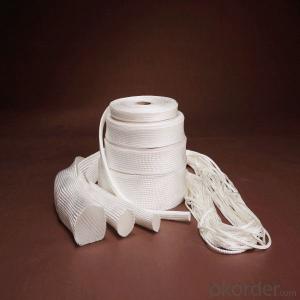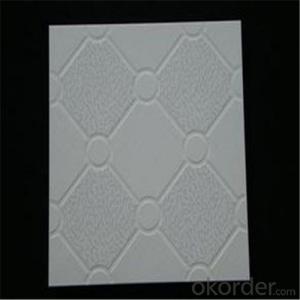Glass Fiber Textiles - 36oz Silica Fiberglass Cloth Resisting 1000°C for Heat Resistance
- Loading Port:
- China main port
- Payment Terms:
- TT OR LC
- Min Order Qty:
- 1000 m
- Supply Capability:
- 100000 m/month
OKorder Service Pledge
OKorder Financial Service
You Might Also Like
Product Description
Silica fiberglass is inorganic fiber that contents more than 96% of SiO2, it's resistant to high temperature, soft point 1700°C, long term service temperature 900 °C, it can work 10 minites at 1450 °C and keeps good state at 1600 °C for 15 seconds. For it's properties of chemical stability, high temperature resistance and ablation resistance, it widely used in aviationand aerospace, metallurgy, chemical, building material and fire fighting industry, etc.
Our factory is the only one that specialized manufacture silica fiberglass in China and has the production line of the whole process from marble making, fiber forming, weaving, and finish. The strength of silica fiberglass made from Na2O-B2O3-SiO2 system glass is 3-5 times higher than that from E glass. The products sold to more than 20 provinces, cities, autonomous regions and exported to foreign countries.
Silica fiberglass products are available in forms of needled mat, fabric, scrim, staple yarn, chopped strand and cord, etc.
Product Properties
1> SiO2>=96%
2> soft point nearly 1700°C, long-time working at 900°C
3> low thermal conductivity
4> good chemical stability
5> good electrical insulation
6> low thermal shrinkage
7> Non-asbestos product without pollution
8> good process performance
Product Uses
High temperature resistant, insulation and sealing material
High temperature ablation resistant material
Fireproof material (for fireproof protective clothe, fireproof curtain, fire blanket)
Dust collecting in media of high temperature gas and filtration in media of high temperature liquid
Filter for molten metal
Distinguisher, insulation material, filtration of automobile and motorcycle
Protective material for welding
Electricity insulation material


- Q: How do glass fiber textiles affect product performance?
- Glass fiber textiles can have a significant impact on product performance in various industries. Firstly, glass fiber textiles provide exceptional strength and durability. The high tensile strength of glass fiber makes it an ideal material for reinforcing products, resulting in increased structural integrity and resistance to breakage or deformation. This is particularly important in applications such as automotive parts, aerospace components, and sporting goods where strength and reliability are crucial. Additionally, glass fiber textiles offer excellent thermal resistance and insulation properties. This makes them highly suitable for products that are exposed to extreme temperatures, such as insulation materials, oven mitts, and fire-resistant clothing. Glass fiber textiles can effectively prevent heat transfer, keeping the product or the user safe and comfortable. Moreover, glass fiber textiles are known for their corrosion resistance. They do not rust or degrade when exposed to moisture, chemicals, or UV radiation. This quality is highly desirable in products used in harsh environments, such as marine equipment, chemical processing plants, and outdoor furniture. Furthermore, glass fiber textiles can enhance the electrical properties of products. Glass fibers have a high dielectric strength, which means they can withstand high voltages without breaking down. This makes them suitable for electrical insulation applications like cables, circuit boards, and transformers. Lastly, glass fiber textiles have a low weight-to-strength ratio, which makes them an attractive choice for lightweight products. This is particularly beneficial in industries such as aerospace, automotive, and sports equipment, where reducing weight while maintaining strength is essential for improved performance and fuel efficiency. In conclusion, glass fiber textiles have a profound impact on product performance. Their strength, durability, thermal resistance, corrosion resistance, electrical properties, and lightweight nature contribute to improved performance, safety, and longevity in a wide range of industries and applications.
- Q: Can glass fiber textile be used in architectural applications?
- Yes, glass fiber textile can be used in architectural applications. Glass fiber textile, also known as fiberglass, is a versatile material that offers several benefits for architectural use. It is lightweight, strong, durable, and has excellent thermal and acoustic insulation properties. These characteristics make it suitable for various architectural applications, such as cladding, roofing, partition walls, and facades. Glass fiber textile can be used as a reinforcing material in composite panels, providing structural support and enhancing the overall strength of the building. It can also be molded into different shapes and forms, allowing for creative and innovative architectural designs. Furthermore, glass fiber textile is resistant to corrosion, moisture, and UV radiation, making it an ideal material for exterior applications. It can withstand harsh weather conditions and requires minimal maintenance, which is a significant advantage for long-term architectural projects. Additionally, glass fiber textile can enhance energy efficiency in buildings. Its excellent insulation properties help reduce heat transfer, leading to lower energy consumption for heating and cooling. This can contribute to sustainability efforts and reduce overall energy costs. In conclusion, glass fiber textile is a suitable material for architectural applications due to its lightweight, strength, durability, insulation properties, and resistance to corrosion. Its versatility and ability to enhance energy efficiency make it a popular choice for various architectural projects.
- Q: Can glass fiber textiles be used in outdoor applications?
- Yes, glass fiber textiles can be used in outdoor applications. They are known for their durability, resistance to harsh weather conditions, and ability to withstand UV radiation. Glass fiber textiles are commonly used in outdoor applications such as awnings, sunshades, outdoor furniture, and outdoor sports equipment.
- Q: Can glass fiber textile be used in luggage?
- Indeed, luggage can incorporate glass fiber textile. Renowned for their remarkable strength and durability, glass fiber textiles prove to be an ideal material for crafting luggage. By interweaving the fibers, a robust fabric is formed, capable of enduring the challenges of travel. Moreover, glass fiber textiles possess the advantage of being lightweight, a desirable quality that facilitates effortless transportation of luggage. Furthermore, these textiles exhibit resistance against water, chemicals, and abrasion, thereby adding an extra layer of protection for the luggage's contents. All in all, glass fiber textiles present a dependable and pragmatic choice for the manufacturing of luggage.
- Q: How does glass fiber textile perform in terms of durability?
- Glass fiber textile is known for its exceptional durability. It has high tensile strength, meaning it can withstand heavy loads and resist tearing or breaking. Additionally, glass fiber textile is highly resistant to chemicals, moisture, and UV radiation, making it suitable for both indoor and outdoor applications. Its durability allows it to maintain its structural integrity and appearance over time, ensuring long-lasting performance in various environments.
- Q: Can glass fiber textiles be used in geotextiles?
- Yes, glass fiber textiles can be used in geotextiles. Glass fiber textiles are known for their high strength, durability, and resistance to chemicals and environmental factors. These properties make them suitable for reinforcing and stabilizing soil in geotechnical applications, such as road construction, erosion control, and retaining walls. Glass fiber geotextiles can provide effective reinforcement, filtration, and separation functions, enhancing the overall performance and longevity of geotechnical structures.
- Q: How do glass fiber textiles contribute to lightweight construction?
- There are several ways in which glass fiber textiles contribute to lightweight construction. To begin with, glass fiber textiles are produced from incredibly thin strands of glass that are woven together to form a fabric. As a result, the material is considerably lighter than traditional construction materials like steel or concrete. This reduced weight is particularly important in industries such as aerospace and automotive, where saving even a kilogram can have a significant impact on fuel efficiency and overall performance. Moreover, glass fiber textiles boast a high strength-to-weight ratio. Despite their lightweight nature, they possess exceptional tensile strength, enabling them to withstand substantial stress and load without breaking or deforming. This makes them a suitable alternative to heavier materials, as they can provide comparable structural integrity while reducing the overall weight of the construction. In addition, glass fiber textiles exhibit corrosion resistance. Unlike metals, which are susceptible to rust and degradation over time, glass fiber textiles do not corrode. This makes them especially suitable for applications in environments exposed to moisture or chemicals, as they can maintain their strength and durability over extended periods. Furthermore, glass fiber textiles offer excellent thermal and electrical insulation properties. They do not conduct heat or electricity, making them ideal for situations where temperature control or electrical safety is of utmost importance. Furthermore, their insulation properties can help minimize heat transfer and enhance energy efficiency, thereby reducing energy consumption. Lastly, glass fiber textiles are highly versatile and can be molded into various shapes and forms. This allows for greater design flexibility and the creation of intricate structures with complex geometries. The ability to customize the material to specific requirements further contributes to lightweight construction, as it allows for optimized designs that maximize strength while minimizing weight. To summarize, glass fiber textiles contribute to lightweight construction by virtue of their inherent lightweight nature, strength, corrosion resistance, thermal and electrical insulation properties, and versatility. These characteristics make them ideal for a wide range of applications where weight reduction is a key priority, enabling the development of lighter, more efficient, and sustainable structures.
- Q: Can glass fiber textile be used in interior design?
- Yes, glass fiber textile can be used in interior design. It is commonly used for wall coverings, curtains, upholstery, and acoustical panels. Glass fiber textile offers various benefits such as durability, fire resistance, sound absorption, and easy maintenance, making it a popular choice for enhancing the aesthetics and functionality of interior spaces.
- Q: Can glass fiber textile be recycled?
- Yes, glass fiber textile can be recycled.
- Q: Can glass fiber textile be used in apparel?
- Yes, glass fiber textile can be used in apparel. It is known for its strength, durability, and resistance to heat and chemicals. However, it is less commonly used in everyday clothing due to its stiffness and lack of breathability. Glass fiber textiles are often utilized in specialized protective clothing, such as fire-resistant suits, industrial uniforms, and military gear.
Send your message to us
Glass Fiber Textiles - 36oz Silica Fiberglass Cloth Resisting 1000°C for Heat Resistance
- Loading Port:
- China main port
- Payment Terms:
- TT OR LC
- Min Order Qty:
- 1000 m
- Supply Capability:
- 100000 m/month
OKorder Service Pledge
OKorder Financial Service
Similar products
Hot products
Hot Searches


























